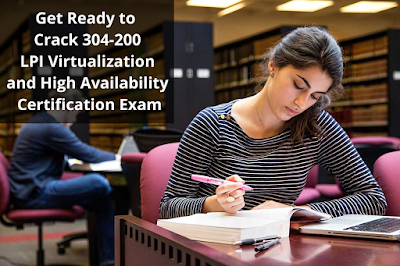The LPI 304-200 Exam is challenging and thorough
preparation is essential for success. This exam study guide is designed to help
you prepare for the LPIC-3 certification exam. It contains a detailed list of
the topics covered on the Professional exam, as well as a detailed list of
preparation resources. These study guides for the LPI Virtualization and High
Availability will help guide you through the study process for your
certification.
304-200 LPI Virtualization and High Availability Exam Summary
- Exam Name: LPI Virtualization and High Availability
- Exam Code: 304-200
- Exam Price: $200 (USD)
- Duration: 90 mins
- Number of Questions: 60
- Passing Score: 500 / 800
- Schedule Exam: LPI Marketplace
- Sample Questions: LPI LPIC-3 Sample Questions
- Recommended Practice: LPI 304-200 Certification Practice Exam
Exam Syllabus: 304-200 LPIC-3 Virtualization and High Availability
1. Virtualization
Virtualization Concepts and
Theory
Weight: 8
Description: Candidates should know and
understand the general concepts, theory and terminology of Virtualization. This
includes Xen, KVM and libvirt terminology.
Key Knowledge Areas:
-
Terminology
-
Pros and Cons of Virtualization
-
Variations of Virtual Machine Monitors
-
Migration of Physical to Virtual Machines
-
Migration of Virtual Machines between Host systems
-
Cloud Computing
The following is a partial list of
the used files, terms and utilities:
-
Hypervisor
-
Hardware Virtual Machine (HVM)
-
Paravirtualization (PV)
-
Container Virtualization
-
Emulation and Simulation
-
CPU flags
-
/proc/cpuinfo
-
Migration (P2V, V2V)
-
IaaS, PaaS, SaaS
Xen
Weight: 9
Description: Candidates should be able to
install, configure, maintain, migrate and troubleshoot Xen installations. The
focus is on Xen version 4.x.
Key Knowledge Areas:
-
Xen architecture, networking and storage
-
Xen configuration
-
Xen utilities
-
Troubleshooting Xen installations
-
Basic knowledge of XAPI
-
Awareness of XenStore
-
Awareness of Xen Boot Parameters
-
Awareness of the xm utility
Terms and Utilities:
-
Domain0 (Dom0), DomainU (DomU)
-
PV-DomU, HVM-DomU
-
/etc/xen/
- xl
-
xl.cfg
-
xl.conf
- xe
-
xentop
KVM
Weight: 9
Description: Candidates should be able to
install, configure, maintain, migrate and troubleshoot KVM installations.
Key Knowledge Areas:
-
KVM architecture, networking and storage
-
KVM configuration
-
KVM utilities
-
Troubleshooting KVM installations
Terms and Utilities:
-
Kernel modules: kvm, kvm-intel and kvm-amd
-
/etc/kvm/
-
/dev/kvm
-
kvm
-
KVM monitor
-
qemu
-
qemu-img
Other Virtualization Solutions
Weight: 3
Description: Candidates should have some
basic knowledge and experience with alternatives to Xen and KVM.
Key Knowledge Areas:
-
Basic knowledge of OpenVZ and LXC
-
Awareness of other virtualization technologies
-
Basic knowledge of virtualization provisioning tools
Terms and Utilities:
-
OpenVZ
-
VirtualBox
-
LXC
-
docker
-
packer
-
vagrant
Libvirt and Related Tools
Weight: 5
Description:
Candidates should have basic knowledge and experience with the libvirt library
and commonly available tools.
Key Knowledge Areas:
-
libvirt architecture, networking and storage
-
Basic technical knowledge of libvirt and virsh
-
Awareness of oVirt
Terms and Utilities:
-
libvirtd
-
/etc/libvirt/
-
virsh
-
oVirt
Cloud Management Tools
Weight: 2
Description: Candidates should have basic
feature knowledge of commonly available cloud management tools.
Key Knowledge Areas:
-
Basic feature knowledge of OpenStack and CloudStack
-
Awareness of Eucalyptus and OpenNebula
Terms and Utilities:
-
OpenStack
-
CloudStack
-
Eucalyptus
-
OpenNebula
High Availability Cluster Management
High Availability Concepts and
Theory
Weight: 5
Description: Candidates should understand the
properties and design approaches of high availability clusters.
Key Knowledge Areas:
-
Understand the most important cluster architectures
-
Understand recovery and cluster reorganization mechanisms
-
Design an appropriate cluster architecture for a given purpose
-
Application aspects of high availability
-
Operational considerations of high availability
Terms and Utilities:
-
Active/Passive Cluster, Active/Active Cluster
-
Failover Cluster, Load Balanced Cluster
-
Shared-Nothing Cluster, Shared-Disk Cluster
-
Cluster resources
-
Cluster services
-
Quorum
-
Fencing
-
Split brain
-
Redundancy
-
Mean Time Before Failure (MTBF)
-
Mean Time To Repair (MTTR)
-
Service Level Agreement (SLA)
-
Disaster Recovery
-
Replication
-
Session handling
Load Balanced Clusters
Weight: 6
Description: Candidates should know how to
install, configure, maintain and troubleshoot LVS. This includes the
configuration and use of keepalived and ldirectord. Candidates should further
be able to install, configure, maintain and troubleshoot HAProxy.
Key Knowledge Areas:
-
Understanding of LVS / IPVS
-
Basic knowledge of VRRP
-
Configuration of keepalived
-
Configuration of ldirectord
-
Backend server network configuration
-
Understanding of HAProxy
-
Configuration of HAProxy
Terms and Utilities:
-
ipvsadm
-
syncd
-
LVS Forwarding (NAT, Direct Routing, Tunneling, Local Node)
-
connection scheduling algorithms
-
keepalived configuration file
-
ldirectord configuration file
-
genhash
-
HAProxy configuration file
-
load balancing algorithms
-
ACLs
Failover Clusters
Weight: 6
Description: Candidates should have
experience in the installation, configuration, maintenance and troubleshooting
of a Pacemaker cluster. This includes the use of Corosync. The focus is on
Pacemaker 1.1 for Corosync 2.x.
Key Knowledge Areas:
-
Pacemaker architecture and components (CIB, CRMd, PEngine, LRMd, DC, STONITHd)
-
Pacemaker cluster configuration
-
Resource classes (OCF, LSB, Systemd, Upstart, Service, STONITH, Nagios)
-
Resource rules and constraints (location, order, colocation)
-
Advanced resource features (templates, groups, clone resources, multi-state
resources)
-
Pacemaker management using pcs
-
Pacemaker management using crmsh
-
Configuration and Management of corosync in conjunction with Pacemaker
-
Awareness of other cluster engines (OpenAIS, Heartbeat, CMAN)
Terms and Utilities:
-
pcs
-
crm
-
crm_mon
-
crm_verify
-
crm_simulate
-
crm_shadow
-
crm_resource
-
crm_attribute
-
crm_node
-
crm_standby
-
cibadmin
-
corosync.conf
-
authkey
-
corosync-cfgtool
-
corosync-cmapctl
-
corosync-quorumtool
-
stonith_admin
High Availability in Enterprise
Linux Distributions
Weight: 1
Description: Candidates should be aware of how
enterprise Linux distributions integrate High Availability technologies.
Key Knowledge Areas:
-
Basic knowledge of Red Hat Enterprise Linux High Availability Add-On
-
Basic knowledge of SUSE Linux Enterprise High Availability Extension
Terms and Utilities:
-
Distribution specific configuration tools
-
Integration of cluster engines, load balancers, storage technology, cluster
filesystems, etc.
High Availability Cluster Storage
DRBD / cLVM
Weight: 3
Description: Candidates are expected to
have the experience and knowledge to install, configure, maintain and
troubleshoot DRBD devices. This includes integration with Pacemaker. DRBD
configuration of version 8.4.x is covered. Candidates are further expected to
be able to manage LVM configuration within a shared storage cluster.
Key Knowledge Areas:
-
Understanding of DRBD resources, states and replication modes
-
Configuration of DRBD resources, networking, disks and devices
-
Configuration of DRBD automatic recovery and error handling
-
Management of DRBD using drbdadm
-
Basic knowledge of drbdsetup and drbdmeta
-
Integration of DRBD with Pacemaker
-
cLVM
-
Integration of cLVM with Pacemaker
Terms and Utilities:
-
Protocol A, B and C
-
Primary, Secondary
-
Three-way replication
-
drbd kernel module
-
drbdadm
-
drbdsetup
-
drbdmeta
-
/etc/drbd.conf
-
/proc/drbd
-
LVM2
-
clvmd
-
vgchange, vgs
Clustered File Systems
Weight: 3
Description: Candidates should know how to
install, maintain and troubleshoot installations using GFS2 and OCFS2. This
includes integration with Pacemaker as well as awareness of other clustered
file systems available in a Linux environment.
Key Knowledge Areas:
-
Understand the principles of cluster file systems
-
Create, maintain and troubleshoot GFS2 file systems in a cluster
-
Create, maintain and troubleshoot OCFS2 file systems in a cluster
-
Integration of GFS2 and OCFS2 with Pacemaker
-
Awareness of the O2CB cluster stack
-
Awareness of other commonly used clustered file systems
Terms and Utilities:
-
Distributed Lock Manager (DLM)
-
mkfs.gfs2
-
mount.gfs2
-
fsck.gfs2
-
gfs2_grow
-
gfs2_edit
-
gfs2_jadd
-
mkfs.ocfs2
-
mount.ocfs2
-
fsck.ocfs2
-
tunefs.ocfs2
-
mounted.ocfs2
-
o2 info
-
o2 image
-
CephFS
-
GlusterFS
-
AFS
LPI 304-200 Certification Sample Questions and Answers
To make you familiar with LPI Virtualization and High
Availability (304-200) certification exam structure, we have prepared this
sample question set. We suggest you to try our Sample Questions for LPIC-3 304 304-200 Certification to test your understanding of
LPI 304-200process with real LPI certification exam environment.
304-200 LPI Virtualization and High
Availability Sample Questions:-
01. When used with KVM, which of the
following block device image formats support snapshots?
a)
qcow
b)
dmg
c)
qcow2
d)
qed
e)
raw
02. Which of the following statements
are true regarding IaaS computing instances?
(Choose
TWO correct answers.)
a)
Creation of new instances can be automated by using scripts or APIs and service
interfaces.
b)
The root file system of a computing instance is always persistent and can be
accessed after the instance is destroyed.
c)
Each and every user of an IaaS cloud has exactly one computing instance.
d)
Once created, computing instances are seldom deleted in order to ensure the
accessibility of the instance's data.
e)
Instances may be created when needed and destroyed when they become obsolete.
03. How does the command to add a new
resource to a Pacemaker cluster using crm begin?
a)
crm manage cluster
b)
crm configure resource
c)
crm service add
d)
crm configure primitive
e)
crm resource new
04. In case one service in a
Pacemaker cluster depends on another service running on the same node, which
score should be assigned to the constraint describing that dependency?
a)
-1
b) 0
c) 1
d)
FORCE
e)
INFINITY
05. Within the graphical output of a
KVM virtual machine, which key sequence switches to the KVM monitor of the VM?
a)
Ctrl-Alt-1
b)
Ctrl-Alt-0
c)
Ctrl-Alt-4
d)
Ctrl-Alt-2
e)
Ctrl-Alt-3
06. How can data be shared between
several virtual machines running on the same Linux-based host system?
a)
By mounting other VM's file systems from /dev/virt-disks/remote/.
b)
By using a network file system or file transfer protocol.
c)
By default, Linux-based virtualization products provide full access to the host
system to all virtual machines.
d)
By setting up a ramdisk in one virtual machine and mounting it using its UUID
in the other VMs.
e)
By attaching the same virtual hard disk to all virtual machines and activating
EXT4 sharing extensions on it.
07. What is the usual way to gain
command line access to computing instances in an IaaS cloud?
a)
By providing a public SSH key to the cloud management system and using the
matching private SSH key to log into the instances.
b)
Usually computing instances are accessed through a web frontend and do not
allow command line access.
c)
By either telnet or SSH using the credentials of the cloud management system
account with administrative privileges.
d)
By using a telnet session with the credentials set and publicized by the
creator of the computing instance's system image.
e)
By using a VNC console which does not require authentication when it is invoked
via the cloud management system.
08. When preparing a public machine
image for the provisioning of new cloud computing instances, which of the
following steps should be done?
(Choose
TWO correct answers.)
a)
Remove all default users and groups, including root and nobody.
b)
Remove all configuration files from /etc/ that were not manually modified.
c)
Remove all confidential data from the image.
d)
Remove all remote login services (i.e. SSH) from the image.
e)
Remove all private SSH keys from the image.
09. Which options to the xl command
will deactivate a running Xen virtual machine?
(Choose
TWO correct answers.)
a)
destroy
b)
remove
c)
shutdown
d)
stop
e)
halt
10. Using Linux Virtual Server (LVS)
without any additional tools provides which of the following features?
a)
Balancing network connections across several backend servers.
b)
Automatically taking over the services of failed nodes.
c)
Restarting failed services on the backend servers.
d)
Checking the integrity of services on backend servers.
e)
Starting and stopping backend servers as needed.
Answers:-
Answer 1:- c
Answer 2:- a, e
Answer 3:- d
Answer 4:- e
Answer 5:- d
Answer 6:- b
Answer 7:- a
Answer 8:- c, e
Answer 9:- a, c

